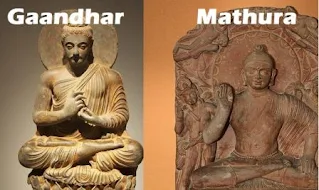Gandhara art
Gandhara art refers to a distinctive style of Buddhist visual art that developed in the ancient region of Gandhara, located in present-day Pakistan and Afghanistan, between the 1st century BCE and the 5th century CE. This art form is a unique blend of Greco-Roman artistic traditions and indigenous Buddhist iconography. Here are the key features of Gandhara art:
1. Greco-Roman Influence:
Gandhara art exhibits a strong influence from Greek and Roman artistic styles due to the region's historical connections with Hellenistic culture after the conquests of Alexander the Great.
Sculptures often depict Buddha and other Buddhist deities in a manner reminiscent of Greek gods, with idealized human forms and realistic facial features.
2. Human Figurines:
Gandhara art is known for its realistic and naturalistic depiction of human figures.
Buddha statues and Bodhisattvas are portrayed wearing Greek-style garments, such as flowing robes and tunics, which cling to the body, revealing its contours.
3. Drapery and Folds:
The drapery in Gandhara sculptures is intricately carved, showing detailed and elaborate folds of clothing.
The artists paid great attention to capturing the natural flow and movement of fabric, which is a characteristic feature of Gandhara art.
4. Halo and Lotus Pedestal:
Buddha images in Gandhara art are often depicted with a halo behind the head, indicating divinity.
Buddha and Bodhisattva figures are typically seated on lotus pedestals, symbolizing purity and enlightenment.
5. Influence of Graeco-Roman Gods:
Some Gandhara sculptures feature figures like Heracles (Hercules) and Atlas, indicating the syncretism of Greek and Buddhist mythologies.
6. Stupas and Monasteries:
Gandhara art also includes architectural elements, with elaborate relief sculptures adorning Buddhist stupas (religious monuments) and monastic complexes.
These reliefs often depict scenes from Buddha's life, Jataka tales, and other Buddhist narratives.
7. Use of Schist Stone:
Gandhara sculptures are primarily carved from gray or green schist stone, which allowed artists to achieve intricate details in their carvings.
8. Iconography:
Gandhara art incorporates traditional Buddhist iconography, such as the Bodhi tree, the wheel of Dharma, and various mudras (hand gestures) representing different aspects of Buddhist teachings.
Gandhara art represents a significant cultural and artistic exchange between the East and the West, creating a unique and enduring legacy in the history of art and Buddhism.


